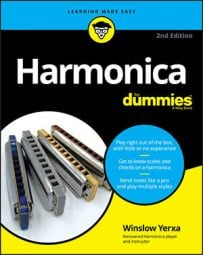Got a shiny new harp all snug in its box? You’re probably eager to crack the lid, pull out that harmonica, and start playing. Let’s start off with a tryout and some basic pointers. Here’s a quick preview.
Picking up the harp
Before you do anything, look at the harp and the printing on the covers. It has a top and a bottom. On the top cover you’ll see the name of the harmonica engraved or stamped into the metal.
Some popular models include the Special 20, Lee Oskar, Blues Session, and Harpmaster. Just above the holes in the front of the harp are the numbers 1 through 10, from left to right. Locating these markings helps you get the harmonica right-side up and facing the right way.
To get your harmonica ready to play, be sure to follow these steps:
When you pick up the harp, make sure the name and hole numbers are on top.
For now, pick up the harmonica by the right and left ends with your forefingers and thumbs, as if you were picking up an ear of corn and getting ready to eat it.
Putting the harp in your mouth
When you’re holding the harp by its ends, place it in your mouth with these steps:
Open your mouth wide like you’re going to yawn.
With your mouth wide open, use your forearms to bring the harmonica to your mouth.
Don’t move your head; move the harmonica instead.
Place the harp between your lips until you feel the harp touching the corners of your mouth, where your top and bottom lips meet.
Let your lips close gently over the covers.
Keep your lips relaxed, resting gently on the harp covers without any lip pressure. Don’t tense them up or curl them inward.
To get a good sound without letting air escape, your lips should form an airtight seal around the harp. If you keep your lips relaxed and you can feel the harmonica touching the corners of your mouth, you should get a good seal.
This video will show you how to get the harmonica in your mouth.
When you first start playing a new harmonica, you don’t need to break it in. Just warm it up first by cupping it in your hands or putting it under your arm for a few minutes.
If you’ve had something to eat or drink recently — especially a sugary or thick beverage or anything oily or with a lot of fragments (such as nuts) — you should rinse your mouth out or even brush your teeth before you try your new harmonica. Food residue can clog up your harp — not to mention make it smell and taste unpleasant.
Breathing through the harp
After you have the harp in your mouth, you can get it to make a sound simply by breathing in and out. For now, no special techniques are required. Just follow these steps:
Try inhaling gently like you’re taking a normal breath.
As you breathe, you should hear a chord, which is several notes sounding at once.
After you’ve inhaled for a few seconds, gently exhale like you’re breathing normally.
You should hear a different chord.
You’ve just discovered one of the coolest things about the harmonica: You get notes and chords by breathing out and also breathing in.
Leave the harp in your mouth for a while and gently alternate between inhaling for a few seconds and then exhaling for a few seconds. Feel the sensation of the harp in your mouth, focus on your breath moving in and out, and listen to the sound of the harp. You do this to get comfortable with the feeling of breathing through the harp.
Moving through the holes
Your mouth may cover two or three holes, but you’ve got ten holes to play around with. Try moving around by sliding the harp sideways in your mouth, so that you slide to the high holes on the right, back through the middle, all the way to the low holes, and back to the middle holes.
The harp should glide easily in your mouth, with no friction, and without dragging your lips along with it.

